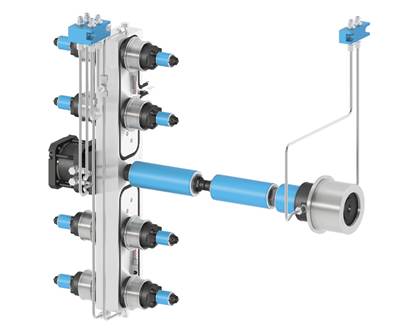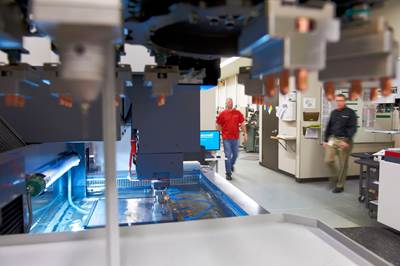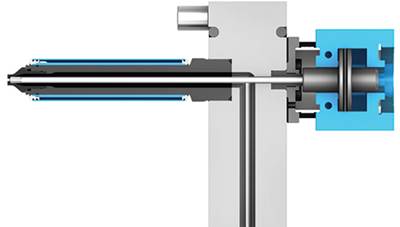
An eight-drop hot runner micro-injection mold with sliding cores for extremely small plastic parts.
Source (All images) | Mold Hotrunner Solutions (MHS), Westfall Technik
There is a growing demand for injection-molded micro parts, which is closely linked to the ongoing miniaturization of medical devices, electronic circuit boards, connectors, hearing aids, bio-absorbable implants and precision healthcare devices. The automated mass production of these high-cavitation, micro-molded plastic parts — often in the tens or hundreds of millions —leaves little room for error. However, this demand also presents substantial opportunities for moldmakers, molders and OEMs that can tackle the unique challenges associated with the production and design of micro parts.
The dimensional accuracy of micro-injection molded plastic parts is measured within an extremely tight tolerance range of only a few microns. For context, a human hair is about 100 microns thick. Ensuring precise replication of these minute measurements, as well as achieving the ideal internal structure (morphology) of the part, is significantly more challenging than for larger thermoplastic parts. From micro-moldmaking to molding, processing and handling the finished product, it is essential to collaborate with experts in the field. It is fair to say that micromolding involves knowledgeable individuals and companies that operate at a completely different level.
A new direct-gating process effectively addresses the challenges related to the frozen layer, temperature and density issues that come with molding on a micro-scale.
Direct Gating Versus Cold Runners
As the volume and size of parts decrease, the challenges faced by micromoldmakers, micro-molders and micro-molding machines increase exponentially. One common solution to this challenge is to mold a micro-part weighing 10 mg with a cold runner that weighs 100 mg. While this approach significantly increases material costs — by a factor of ten — it also results in longer cooling and cycle times. However, there are additional considerations to take into account, such as the quality of the micro part itself.
Direct-gated micro parts that produce zero scrap are preferable. To understand why, it's essential to examine what happens inside a micro molding cavity during injection. No one wants a high-quality cold runner that ultimately gets wasted. We need to look beyond the gate and analyze how the thermoplastic melt fills the microcavity. This understanding is crucial for producing better quality parts in terms of physical properties, dimensional consistency and the accuracy of replicating the part's micro features.

The graph illustrates a new injection process used to produce better quality micro parts by utilizing continuously compressed melt in the barrel and valve gate hot runner, then delivering ultra-high injection velocity with controlled melt expansion.
A Closer Look Inside the Cavity
Let’s look at how a microcavity fills, in both a systematic and scientific way:
Compressibility used as a melt velocity booster. Plastic melt is compressible, expanding and contracting depending on temperature, pressure and time. This behavior is due to the free space between their macromolecules. When compressed, molten plastic can store visco-elastic energy, which is released as flow velocity when it relaxes. The energy within the condensed melt effectively fills the cavity without the need for precise metering. In fact, metering a micro-volume is not accurate and presents too much room for error, particularly in conventional micro-molding methods.
Viscosity. Plastic melt is viscous and tends to resist flow under pressure. However, it typically flows more easily at higher temperatures and pressures because the shear within the material reduces its viscosity. Certain polymers exhibit a significant shear-thinning effect at high shear rates. Molecules can entangle at pressure and disentangle with directional flow and molecular alignment. High molecular orientation achieved through fast flow in thin and narrow cavities is beneficial, especially along the walls, during the rapid cooling of features with varying thicknesses. Near-instant part injection creates a stronger and more uniform skin-core structure.
Enthalpy. Plastic melt contains heat energy, known as enthalpy, which is measured in joules per gram or calories per gram. This represents the amount of thermal energy present at the processing temperature. To melt 1 gram of plastic pellets from room temperature to the processing temperature, and vice versa, to cool the melt back down to room temperature, reverses the energy transfer cyclically from heating to cooling. A low enthalpy indicates that the type of plastic requires less energy to melt, and it also freezes and cools more easily.

A micro plastic part (bone screw for medical application) direct-gated in PEEK, weighing only 0.04g (0.00141 ounces) and measuring 9.3mm (0.366”) in length. The analysis shows the consistent quality of the melt and thin frozen layer formation associated with near-instant injection.
Melt integrity. Plastic melt is thermally sensitive to degradation over time. As the residence time of the melt increases at elevated processing temperatures, molecular breakdown occurs, resulting in a loss of physical properties, discoloration and potential outgassing. The main reason for this issue is the natural molecular motion among the plastic molecules when heated and in a free expanded volume.
The stronger the molecular bond, the less residence time-sensitive the melt is. For example, POM (Polyoxymethylene) is known to be one of the most residence-time sensitive materials. However, this sensitivity can be overcome to some extent by lowering the temperature or maintaining pressure. These actions reduce the free volume and suppress molecular motion within the melt.
The most effective way to improve melt residence time is to keep the melt under continuous pressure. This approach reduces free volume by compressing the melt by approximately 5-10%, which keeps the molecules more stable inside the confined space of the barrel cushion and the melt channels of the hot runner.
If you can measure it, you can control it.
Part quality. When the melt pressure is increased, the plastic melt undergoes changes that increase the solidification or transition temperature. Cooling the melt in the cavity under higher melt pressure leads to a higher material density in the finished part, resulting in reduced shrinkage. By leveraging these known plastic properties in a new micro-injection process, we can produce higher-quality micro parts.
The primary objective is to achieve near-isotropic conditions as the micro-cavity fills with the melt and solidifies to form a high-quality micropart. The goal is to fill the cavity in an isobaric and isothermal way or with as small a melt temperature gradient and pressure gradient throughout the cavity/part as possible.
Injection speed. The main goal is to achieve an extremely fast fill time of only about 10 to 20 milliseconds, which is nearly instantaneous (for reference, there are 1,000 milliseconds in a second). To achieve the required injection viscosity or high-speed ‘fill front’ into the microcavity, pressurized and condensed melt is required. This is facilitated by a highly specialized hot runner valve gate system that provides instant expansion when the valve gate opens (force from the elastic energy stored in the compressed melt).
A direct-gated micro part with a gate diameter of only 0.5 mm (0.020 inches) enables the melt to fill the part with almost instant cavity pressure (as illustrated in the cavity melt pressure graph for a 15 mg LCP30-GF micro part) at a fill time of 10 milliseconds, followed by a valve closing time of 50 milliseconds. From a moldmaking perspective, vacuum venting the cavity supports these ultra-fast injection speeds.

Downstream part handling, cavity inspection, temperature control and ultra-sensitive pressure sensors must all work together to deliver better micro parts and to offer total transparency for data acquisition and quality control.
Specialized Process and Equipment Must Include Accurate Sensors
If you can measure it, you can control it. A controlled plunger force within the melt distribution manifold maintains the cavity pressure of the system. The speed of this expansion process prevents the formation of frozen layers, which is common with the relatively slow injection speed of conventional micro-molding machines that produce multiple micro parts using a branched cold runner.
All cold runner channels tend to slow down the melt velocity, which leads to the creation of frozen layers as the cavity fills at a relatively slow speed and during cavity pressure buildup, causing a melt temperature gradient in the part as it forms. The final product is non-isobaric and non-isothermal, producing less favorable polymer morphology.
In contrast, the direct-gate process reduces shrinkage, minimizes frozen stress and increases polymer density. As a result, the parts produced exhibit much-improved material properties. Additionally, it enables the accurate, consistent and reliable reproduction of minute but crucial features, including those with very small wall thicknesses, enabling the part to function as designed.
The Future of Micro Molding
With this innovative direct-gating process, micro parts are no longer just an appendage at the end of a large cold runner or an afterthought of conventional injection molding. This new process introduces a completely new method for producing extremely small, high-quality plastic parts. It effectively addresses the challenges related to the frozen layer, temperature and density issues that come with molding on a micro-scale. Not only does it lead to the production of better parts, but it also saves valuable materials like PEEK, LCP and bio-resins, from ending up on the scrap heap in the form of outdated cold runner systems.
Related Content
Solving Mold Alignment Problems with the Right Alignment Lock
Correct alignment lock selection can reduce maintenance costs and molding downtime, as well as increase part quality over the mold’s entire life.
Read MoreHands-on Workshop Teaches Mold Maintenance Process
Intensive workshop teaches the process of mold maintenance to help put an end to the firefighting culture of many toolrooms.
Read MoreMachining Center Spindles: What You Need to Know
Why and how to research spindle technology before purchasing a machining center.
Read MoreHow to Eliminate Chatter
Here are techniques commonly used to combat chatter and guidelines to establish a foundation for optimizing the moldmaking process.
Read MoreRead Next
Benefits of the Internal Valve Gate
Not everyone is familiar with how internal valve gate nozzles work and when to use them.
Read MoreFour Micro Tooling Considerations
Issues involving gating, ejection, mold splits and direction of pull are of special concern when it comes to micro tooling.
Read MoreNo More Cooling Required
Moldmakers and molders can increase mold uptime using today’s cooling-free valve gate actuators.
Read More





















